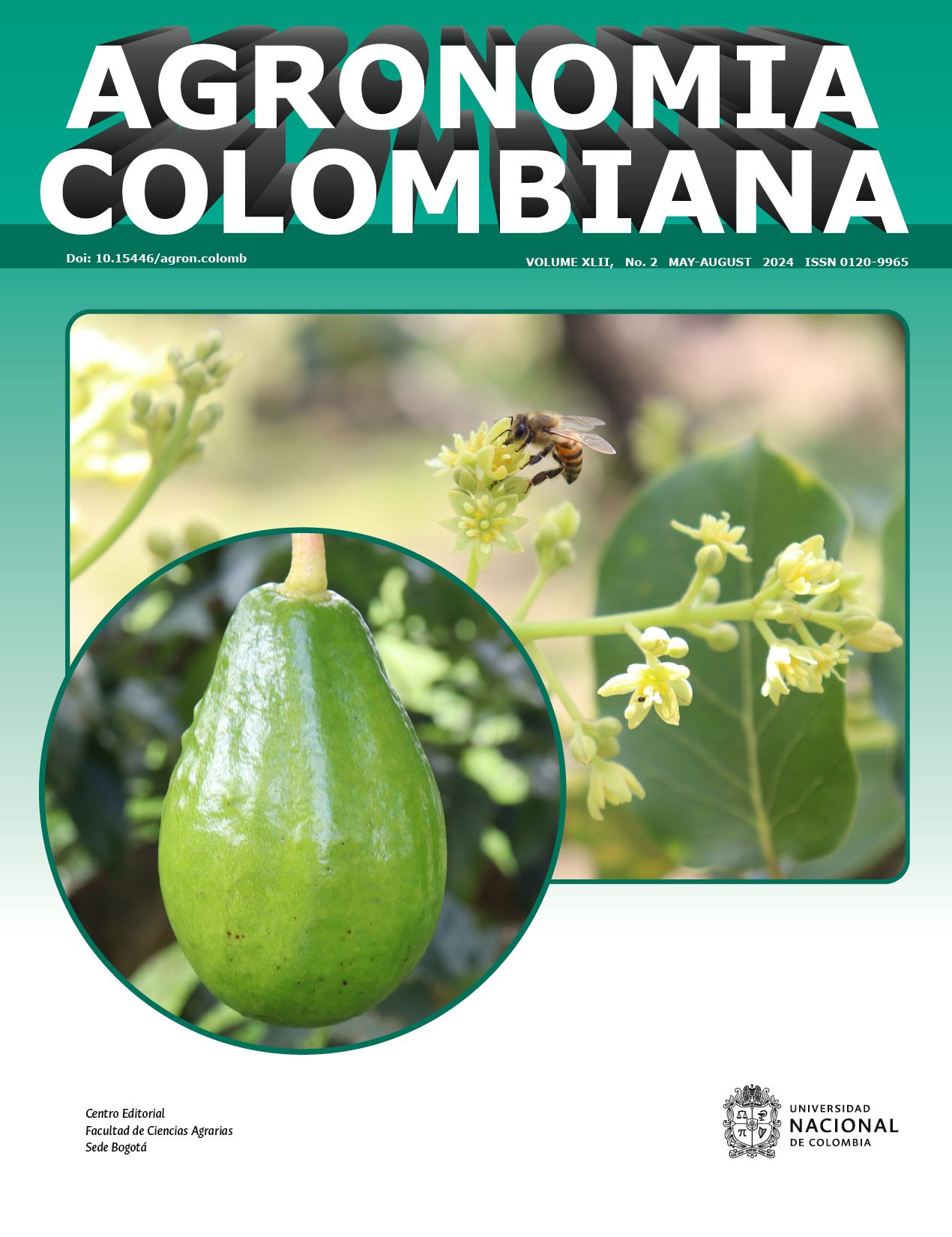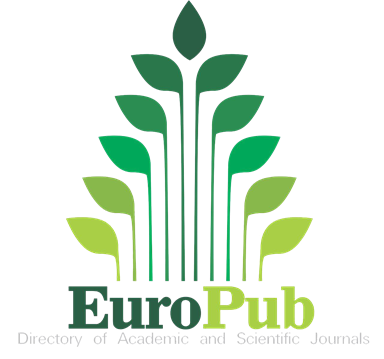Invasive aquatic plants as a mixed substrate with Red Ferralitic soil in vegetable seedbeds
Plantas acuáticas invasoras como un sustrato mezclado con suelo Ferralítico Rojo en semilleros de hortalizas
DOI:
https://doi.org/10.15446/agron.colomb.v42n2.115670Keywords:
Eichhornia crassipes, Pistia stratiotes, seedlings, Dickson quality index, tomato, pepper (en)Eichhornia crassipes, Pistia stratiotes, plántulas, Dickson quality index, tomate, pimiento (es)
Downloads
The composition of the substrates in the vegetable seedbed phase is important for subsequent transplanting. The aim of this study was to evaluate the use of dry mass of the invasive aquatic plants Pistia stratiotes L. and Eichhornia crassipes (Mart.) Solms as a substrate mixed with Red Ferralitic soil for seedbeds of tomato and pepper. To plant tomato and pepper seeds, 300 alveoli were prepared with a mixture of Red Ferralitic soil with different proportions of dry mass of P. stratiotes (0.5% and 1.0%) and E. crassipes (2.0% and 4.0%). At 28 and 40 d after sowing, 30 seedlings per treatment were selected and the average length and diameter of the stem and primary root (cm) were measured. The Dickson quality index was determined in order to select the best treatment. The average stem length was greater in seedlings treated with P. stratiotes (0.5%) and E. crassipes (2.0%) and the diameter was greater in tomato seedlings treated with P. stratiotes (1.0%) and pepper seedlings with P. stratiotes (0.5%); this showed significant differences from the rest of the treatments. The maximum length and diameter of the primary root varied between treatments for both vegetables. The best treatments for the initial growth of tomato and pepper were those when Red Ferralitic soil and dry mass of P. stratiotes (0.5% and 1.0%) and E. crassipes (2.0%) were used as a mixed substrate.
La composición de los sustratos, en la fase de semillero de hortalizas, es importante para su posterior trasplante. El objetivo de este estudio fue evaluar el uso de masa seca de las plantas acuáticas invasoras Pistia stratiotes L. y Eichhornia crassipes (Mart.) Solms como sustrato mezclado con suelo Ferralítico Rojo en semilleros de tomate y pimiento. Para plantar semillas de tomate y pimiento se prepararon 300 alvéolos con una mezcla de suelo Ferralítico Rojo y diferentes proporciones de masa seca de P. stratiotes (0,5% y 1,0%) y E. crassipes (2,0% y 4,0%). Luego de 28 y 40 d de siembra respectivamente, se seleccionaron 30 plántulas por tratamiento y se les midieron la longitud y diámetro promedio del tallo y de la raíz primaria (cm). Se determinó el índice de calidad de Dickson para seleccionar el mejor tratamiento. La longitud promedio del tallo fue mayor en las plántulas tratadas con P. stratiotes (0,5%) y E. crassipes (2,0%) y el diámetro fue mayor en las plántulas de tomate tratadas con P. stratiotes (1,0%) y de pimiento con P. stratiotes (0,5%), mostrando diferencias significativas con el resto de los tratamientos. La longitud máxima y el diámetro de la raíz primaria variaron entre tratamientos para ambas hortalizas. Los mejores tratamientos para el crecimiento inicial de tomate y pimiento fueron aquellos donde se utilizó suelo Ferralítico Rojo y masa seca de P. stratiotes (0,5% y 1,0%) y E. crassipes (2,0%) como sustrato mezclado.
References
Acevedo-Alcalá, P., Cruz-Hernández, J., & Taboada-Gaytán, O. R. (2020). Abonos orgánicos comerciales, estiércoles locales y fertilización química en la producción de plántula de chile poblano. Revista Fitotecnia Mexicana, 43(1), 35–44. https://doi.org/10.35196/rfm.2020.1.35
Alarcón-Zayas, A. (2013). Calidad poscosecha del tomate (Solanum lycopersicum L.) cultivado en sistemas ecológicos de fertilización [Doctoral dissertation, Universidad Politécnica de Madrid]. https://doi.org/10.20868/UPM.thesis.21908
Álvarez, F., & Pino, M. T. (2018). Aspectos generales del manejo agronómico del pimiento en Chile. In M. T. Pino (Ed.), Pimientos para la industria de alimentos e ingredientes (Boletín INIA No. 360, pp. 41–57). Santiago, Chile, Instituto de Investigaciones Agropecuarias. https://bibliotecadigital.ciren.cl/server/api/core/bitstreams/924cadc6-2c90-47b7-b666-c6305c5e1512/content#page=43
Álvarez-Romero, P. I., Infante Pilco, K. F., Zambrano Pontón, R. G., & Ferreira e Ferreira, A. F. T. (2022). Fenotipado y evaluación de la calidad de plántulas de pimiento (Capsicum annuum L.) en semilleros con diferente intensidad de luz artificial y sustratos. Polo del Conocimiento, 7(8), 767–793. https://www.polodelconocimiento.com/ojs/index.php/es/article/view/4424
Anjos, G. L., Souza, G. S., Fagundes, D. C., & Santos, A. R. (2017). Initial growth of sweet pepper in different substrates and light environments. Científica, 45(4), 406–413. https://doi.org/10.15361/1984-5529.2017v45n4p406-413
Barboza, G. E., & Bianchetti, L. B. (2005). Three new species of Capsicum (Solanaceae) and a key to the wild species from Brazil. Systematic Botany, 30(4), 863–871. https://www.jstor.org/stable/25064115 DOI: https://doi.org/10.1600/036364405775097905
Barrios, O., Fuentes, V., Cristóbal, R., Shagardosky, T., Fundora, Z., Castiñeiras, L., Moreno, V., Fernández, L., García, M., & Hernández, F. (2005). Diversidad morfológica del género Capsicum conservada en huertos caseros de Cuba. Agrotecnia de Cuba (Special issue), 48–65. https://www.grupoagricoladecuba.gag.cu/media/Agrotecnia/pdf/2005/Trabajos/AGEN06.pdf
Del Valle-Echevarría, A. R., Kantar, M. B., Branca, J., Moore, S., Frederiksen, M. K., Hagen, L., Hussain, T., & Baumler, D. J. (2019). Aeroponic cloning of Capsicum spp. Horticulturae, 5(2), Article 30. https://doi.org/10.3390/horticulturae5020030
Dhaliwal, G. S., Gupta, N., Kukal, S. S., & Meetpal-Singh. (2014). Standardization of automated Vario EL III CHNS analyzer for total carbon and nitrogen determination in plants. Communications in Soil Science and Plant Analysis, 45(10), 1316–1324. https://doi.org/10.1080/00103624.2013.875197
Dickson, A., Leaf, A. L., & Hosner, J. F. (1960). Quality appraisal of white spruce and white pine seedlings stock in nurseries. The Forestry Chronicle, 36(1), 10–13. https://doi.org/10.5558/tfc36010-1
Domínguez-Liévano, A., & Espinosa-Zaragoza, S. (2021). Evaluación de sustratos alternativos en la germinación y crecimiento inicial de Hymenaea courbaril L. en condiciones de vivero. Revista Forestal del Perú, 36(1), 107–117. https://doi.org/10.21704/rfp.v1i36.1707
Fernández-Delgado, J., Hernández-Díaz, M. I., & Salgado-Pulido, J. M. (2021). Sistemas de biofertilización en el cultivo del tomate (Solanum lycopersicum L.). Avances, 23(4), 384–392. https://avances.pinar.cu/index.php/publicaciones/article/view/650
González-Domínguez, J., de León-Ortiz, M. E., Machado-Contreras, I., Pineda-Ruiz, E. B., & Viñas-Quintero, Y. (2019). Respuesta de caña de azúcar a la aplicación de fertilizantes minerales en Ciego de Ávila. Revista Ingeniería Agrícola, 9(3), 16–22. https://revistas.unah.edu.cu/index.php/IAgric/article/view/1138
Hernández-Fernández, L., Méndez, I. E., Vázquez, J. G., González de Zayas, R., & Lorenzo Feijoo, J. C. (2023). Aquatic plants in the freshwater artificial lagoons in Ciego de Ávila, Cuba. Intropica, 18(1), 37–49. https://doi.org/10.21676/23897864.4753
Hernández-Huerta, J., Tamez-Guerra, P., Gomez-Flores, R., Delgado-Gardea, M. C. E., Robles-Hernández, L., Gonzalez-Franco, A. C., & Infante-Ramirez, R. (2023). Pepper growth promotion and biocontrol against Xanthomonas euvesicatoria by Bacillus cereus and Bacillus thuringiensis formulations. PeerJ, 11, Article e14633. https://doi.org/10.7717/peerj.14633
Hernández-Jiménez, A., Pérez-Jiménez, J. M., Bosch-Infante, D., & Castro-Speck, N. (2015). Clasificación de los suelos de Cuba 2015. Editorial INCA. https://ediciones.inca.edu.cu/files/libros/clasificacionsueloscuba_%202015.pdf
Honmura, T. (2000). Studies on the ecology and the utilization of water hyacinth (Eichhornia crassipes (Mart.) Solms.) [Doctoral dissertation, Kagoshima University]. https://cir.nii.ac.jp/crid/1570854175739665792
Ibiza, V. P., Blanca, J., Cañizares, J., & Nuez, F. (2012). Taxonomy and genetic diversity of domesticated Capsicum species in the Andean region. Genetic Resources and Crop Evolution, 59, 1077–1088. https://doi.org/10.1007/s10722-011-9744-z
López-Marín, L. M. (2017). Manual técnico del cultivo de tomate (Solanum lycopersicum). Instituto Nacional de Innovación y Transferencia en Tecnología Agropecuaria, Costa Rica. http://repositorio.iica.int/handle/11324/3143
Luna-Murillo, R. A., Reyes Pérez, J. J., López Bustamante, R. J., Reyes Bermeo, M., Murillo Campuzano, G., Samaniego Armijos, C., Espinoza Coronel, A., Ulloa Méndez, C., & Travéz Travéz, R. (2015). Abonos orgánicos y su efecto en el crecimiento y desarrollo del cultivo del tomate (Solanum lycopersicum L.). Centro Agrícola, 42(4), 69–76. https://biblat.unam.mx/hevila/Centroagricola/2015/vol42/no4/9.pdf
Moya, C., Arzuaga, J., Amat, I., Santiesteban, L., Álvarez, M., Plana, D., Dueñas, F., Florido, M., Hernández, J., & Fonseca, E. (2009). Evaluación y selección participativa de nuevas líneas y variedades de tomate (Solanum lycopersicum L.) en la región oriental de Cuba. Cultivos Tropicales, 30(2), 66–72. https://ediciones.inca.edu.cu/index.php/ediciones/article/view/149
Oksanen, J., Kindt, R., & O’Hara, B. (2005). Community ecology package. The vegan Package, version 1.6-10. http://sortie-admin.readyhosting.com/lme/R%20Packages/vegan.pdf
Pino, J., Fuentes, V., & Barrios, O. (2011). Volatile constituents of Cachucha peppers (Capsicum chinense Jacq.) grown in Cuba. Food Chemistry, 125(3), 860–864. https://doi.org/10.1016/j.foodchem.2010.08.073
Pino, M. T. (Ed.). (2018). Pimientos para la industria de alimentos e ingredientes. Boletín INIA No. 360. Instituto de Investigaciones Agropecuarias, Santiago, Chile. https://bibliotecadigital.ciren.cl/server/api/core/bitstreams/924cadc6-2c90-47b7-b666-c6305c5e1512/content#page=43
Porta-Siota, F., Morici, E. F. A., & Petruzzi, H. J. (2021). Emergencia de plántulas en siembras para rehabilitación ecológica de pastizales: el caso de Piptochaetium napostaense. Semiárida, 31(2), 57–62. https://cerac.unlpam.edu.ar/index.php/semiarida/article/view/6000 DOI: https://doi.org/10.19137/semiarida.2021(02).57-62
Quiñones-López, C. A. (2023). Evaluación ambiental de escenarios de producción y distribución de alimentos de origen agrícola en la región metropolitana. Caso de estudio: hortalizas [Master thesis, Universidad de Chile]. https://repositorio.uchile.cl/handle/2250/194880
R Core Team. (2018). R: A language and environment for statistical computing. R Foundation for Statistical Computing: Vienna, Austria.
Reyes, M. S. (2023). Seguridad alimentaria y promoción del consumo de frutas y hortalizas: valoración de la aceptabilidad de batidos vegetales. Centro de Estudios Interdisciplinarios, Universidad Nacional de Rosario, Argentina
Reyes-Pérez, J. J., Luna-Murillo, R. A., Reyes Bermeo, M. R., Vázquez Morán, V. F., Zambrano Burgos, D., & Torres Rodríguez, J. A. (2018). Efecto de abonos orgánicos sobre la respuesta productiva en el tomate (Solanum lycopersicum L.). Revista de la Facultad de Agronomía de la Universidad del Zulia, 35(1), 26–39. https://produccioncientificaluz.org/index.php/agronomia/article/view/27259
Rodríguez-Chow, J., & Trujillo-Mendoza, R. (2013). Evaluación de sustratos y proporciones NPK en plántulas de tomate (Solanum lycopersicum Mill) en túnel, aplicando el método doble trasplante, CNRA del Campus Agropecuario de la UNAN-León, periodo marzo-abril 2013 [Undergraduate thesis, Universidad Autónoma de Nicaragua-León]. http://riul.unanleon.edu.ni:8080/jspui/handle/123456789/6407?mode=full
Rodríguez-Delgado, I., Pérez Iglesias, H., García Batista, R. M., & Sánchez Mosquera, J. V. (2021). Comportamiento morfoagroproductivo de diferentes cultivares de pimiento (Capsicum annuum L.) en la parroquia La Victoria, Ecuador. Revista Científica Agroecosistemas, 9(3), 92–103. https://aes.ucf.edu.cu/index.php/aes/article/view/498
Saavedra Del Real, G. (2019). Pimiento y ají (Capsicum annuum). In G. Saavedra Del Real, C. Jana Ayala, & E. Kehr Mellado (Eds.). Hortalizas para procesamiento agroindustrial. Boletín INIA No. 411 (pp. 121–181). Instituto de Investigaciones Agropecuarias, Temuco, Chile. https://pdfcoffee.com/nr41810-pdf-pdf-free.html
Serra, J. J. (2019). Reglamento (UE) 2019/1009: un paso adelante para la industria de los fertilizantes. Phytoma: Revista Profesional de Sanidad Vegetal, (312), 12–15. https://www.boe.es/doue/2019/170/L00001-00114.pdf
Silva, R. R., Santos, A. C. M., Faria, A. J. G., Rodrigues, L. U., Alexandrino, G. C., & Nunes, B. H. N. (2018). Alternative substrates in the production of seedlings peppers. Journal of Bioenergy and Food Science, 5(1), 12–21. http://periodicos.ifap.edu.br/index.php/JBFS/article/view/152/200 DOI: https://doi.org/10.18067/jbfs.v5i1.152
Sims, W. L. (1980). History of tomato production for industry around the world. Acta Horticulturae, 100, 25–26. https://doi.org/10.17660/ActaHortic.1980.100.1
Solís-Sandoval, S., Gómez-Romero, M., & Velázquez-Becerra, C. (2019). Viabilidad y germinación de semilla de Cordia elaeagnoides A. DC. Polibotánica, (48), 121–134. https://www.encb.ipn.mx/assets/files/encb/docs/polibotanica/revistas/pb48/cordia.pdf DOI: https://doi.org/10.18387/polibotanica.48.10
Sondang, Y., Anty, K., & Siregar, R. (2021). Isolation and identification of effective microorganisms from water hyacinth biofertilizer. Seventh international conference on Sustainable Agriculture, Food and Energy. IOP Publishing. https://doi.org/10.1088/1755-1315/709/1/012064
Tang, Q., Cotton, A., Wei, Z., Xia, Y., Daniell, T., & Yan, X. (2022). How does partial substitution of chemical fertiliser with organic forms increase sustainability of agricultural production? Science of The Total Environment, 803(10), Article 149933. https://doi.org/10.1016/j.scitotenv.2021.149933
Wamba, O., Taffouo, V., Youmbi, E., Ngwene, B., & Amougou, A. (2012). Effects of organic and inorganic nutrient sources on the growth, total chlorophyll and yield of three bambara groundnut landraces in the coastal region of Cameroon. Journal of Agronomy, 11(2), 31–42. http://scialert.net/fulltext/?doi=ja.2012.31.42&org=11 DOI: https://doi.org/10.3923/ja.2012.31.42
How to Cite
APA
ACM
ACS
ABNT
Chicago
Harvard
IEEE
MLA
Turabian
Vancouver
Download Citation
License
Copyright (c) 2024 Agronomía Colombiana

This work is licensed under a Creative Commons Attribution-NonCommercial-ShareAlike 4.0 International License.
© Centro Editorial de la Facultad de Ciencias Agrarias, Universidad Nacional de Colombia
Reproduction and quotation of material appearing in the journal is authorized provided the following are explicitly indicated: journal name, author(s) name, year, volume, issue and pages of the source. The ideas and observations recorded by the authors are their own and do not necessarily represent the views and policies of the Universidad Nacional de Colombia. Mention of products or commercial firms in the journal does not constitute a recommendation or endorsement on the part of the Universidad Nacional de Colombia; furthermore, the use of such products should comply with the product label recommendations.
The Creative Commons license used by Agronomia Colombiana journal is: Attribution - NonCommercial - ShareAlike (by-nc-sa)

Agronomia Colombiana by Centro Editorial of Facultad de Ciencias Agrarias, Universidad Nacional de Colombia is licensed under a Creative Commons Reconocimiento-NoComercial-CompartirIgual 4.0 Internacional License.
Creado a partir de la obra en http://revistas.unal.edu.co/index.php/agrocol/.




















